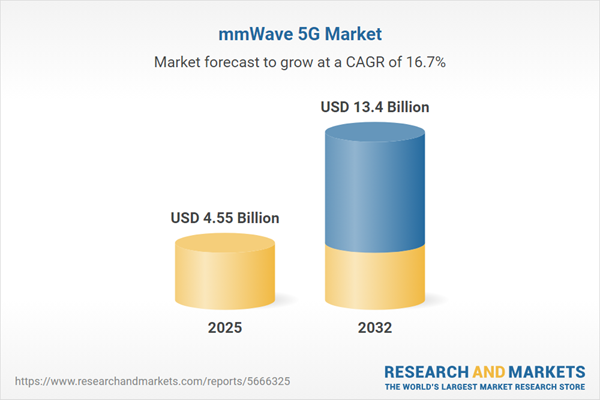Speak directly to the analyst to clarify any post sales queries you may have.
The mmWave 5G market is experiencing marked transformation as technological advancements, industry collaborations, and regulatory initiatives open new growth opportunities for connectivity providers and their enterprise clients.
Market Snapshot: Growth Profile for the mmWave 5G Market
The global mmWave 5G market grew from USD 3.90 billion in 2024 to USD 4.55 billion in 2025. Ongoing investments and innovation drive its projected expansion at a CAGR of 16.67%, with the market expected to reach USD 13.40 billion by 2032. This robust growth reflects mounting enterprise demand for high-capacity, low-latency, and scalable wireless solutions across a diverse set of sectors and geographies.
Scope & Segmentation of the mmWave 5G Market
This report provides an in-depth analysis of the mmWave 5G market, spanning component types, applications, industries, deployment scenarios, and regions.
- Component Types: Customer premises equipment, infrastructure equipment including macro and micro base stations, repeaters, small cells (indoor, rural outdoor, urban outdoor), and RF modules such as antenna modules (MIMO and patch antennas), filter modules, and transceiver modules.
- Application Areas: Enhanced mobile broadband (smartphones, tablets, wearables), fixed wireless access (enterprise, residential), industrial IoT (energy, logistics, manufacturing), private networks (campus, industrial settings), telemedicine (remote monitoring, surgery), and vehicle-to-everything (infrastructure-to-vehicle, vehicle-to-vehicle).
- End-User Industries: Automotive, consumer electronics, government and defense, healthcare, manufacturing, and telecom operators.
- Deployment Scenarios: Indoor (enterprise and residential) and outdoor (rural, suburban, urban) rollouts, addressing site-specific requirements.
- Regional Coverage: Americas (United States, Canada, Mexico, Brazil, Argentina, Chile, Colombia, Peru), Europe, Middle East & Africa (including United Kingdom, Germany, France, Russia, Italy, Spain, Netherlands, Sweden, Poland, Switzerland, United Arab Emirates, Saudi Arabia, Qatar, Turkey, Israel, South Africa, Nigeria, Egypt, Kenya), and Asia-Pacific (China, India, Japan, Australia, South Korea, Indonesia, Thailand, Malaysia, Singapore, Taiwan).
- Leading Companies: Telefonaktiebolaget LM Ericsson (publ), Huawei Investment & Holding Co., Ltd., Nokia Corporation, ZTE Corporation, Samsung Electronics Co., Ltd., NEC Corporation, Fujitsu Limited, Casa Systems, Inc., CommScope, Inc., Qualcomm Incorporated.
Key Takeaways for the mmWave 5G Market
- Innovative beamforming and advanced antenna systems enhance coverage and reliability, enabling expansion into dense urban and challenging environments.
- Openness in network architecture fosters collaboration between hardware, software, and component providers, supporting modular deployments for diverse client requirements.
- Integrated radio frequency front ends and optimized semiconductor processes lower power usage and heat generation, addressing deployment cost and scalability issues.
- Stakeholders’ ability to balance capital investment with evolving consumer and enterprise connectivity needs is critical for successful widespread adoption.
- Emerging private network models for manufacturing, healthcare, and automotive sectors are driving new opportunities for differentiated connectivity services.
- Collaboration with regulators and ecosystem partners remains essential for streamlined site access, spectrum allocation, and cross-sector synergies.
Tariff Impact: U.S. Trade Policy and mmWave 5G Supply Chains
Recent United States tariffs on mmWave 5G equipment have increased landed costs for network operators and prompted significant shifts in procurement strategy. Companies are responding by diversifying supply sources, reshoring select manufacturing, and building localized assembly facilities. While these adaptations ensure business continuity, they also introduce additional complexity to supply chain logistics, budget planning, and project timelines. Flexible procurement models and adaptive supply strategies will remain vital as global trade dynamics evolve.
Methodology & Data Sources
This research integrates primary interviews with industry experts, comprehensive secondary data from regulatory and market databases, and analytic triangulation techniques. These rigorous processes ensure qualitative insights are validated against quantitative benchmarks across adoption, spectrum use, and infrastructure deployment metrics.
Why This Report Matters for Senior Decision-Makers
- Enables accurate assessment of emerging opportunities and strategic risks in high-growth mmWave 5G segments across verticals and regions.
- Offers actionable recommendations to align technology investments, procurement strategies, and stakeholder engagement with evolving market realities.
- Facilitates agile planning by highlighting regulatory, supply chain, and partner dynamics critical to sustainable network rollouts and ROI optimization.
Conclusion
The mmWave 5G market is set to redefine enterprise connectivity by leveraging advanced radio technologies, ecosystem collaboration, and adaptive supply strategies. Senior leaders can use these insights to guide investment decisions and position their organizations for future-ready network architectures.
Additional Product Information:
- Purchase of this report includes 1 year online access with quarterly updates.
- This report can be updated on request. Please contact our Customer Experience team using the Ask a Question widget on our website.
Table of Contents
3. Executive Summary
4. Market Overview
7. Cumulative Impact of Artificial Intelligence 2025
Companies Mentioned
The companies profiled in this mmWave 5G market report include:- Telefonaktiebolaget LM Ericsson (publ)
- Huawei Investment & Holding Co., Ltd.
- Nokia Corporation
- ZTE Corporation
- Samsung Electronics Co., Ltd.
- NEC Corporation
- Fujitsu Limited
- Casa Systems, Inc.
- CommScope, Inc.
- Qualcomm Incorporated
Table Information
| Report Attribute | Details |
|---|---|
| No. of Pages | 184 |
| Published | October 2025 |
| Forecast Period | 2025 - 2032 |
| Estimated Market Value ( USD | $ 4.55 Billion |
| Forecasted Market Value ( USD | $ 13.4 Billion |
| Compound Annual Growth Rate | 16.6% |
| Regions Covered | Global |
| No. of Companies Mentioned | 11 |









